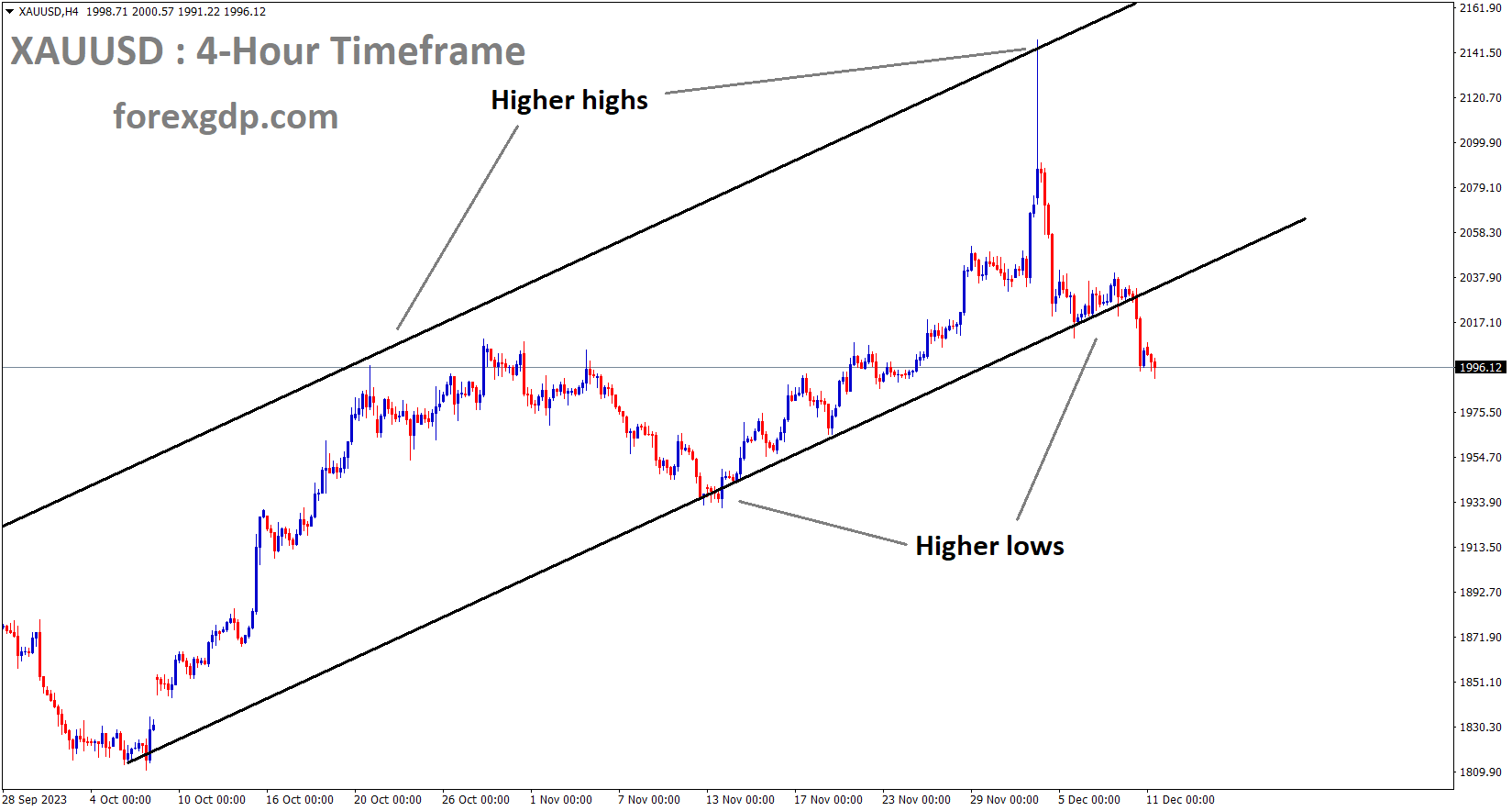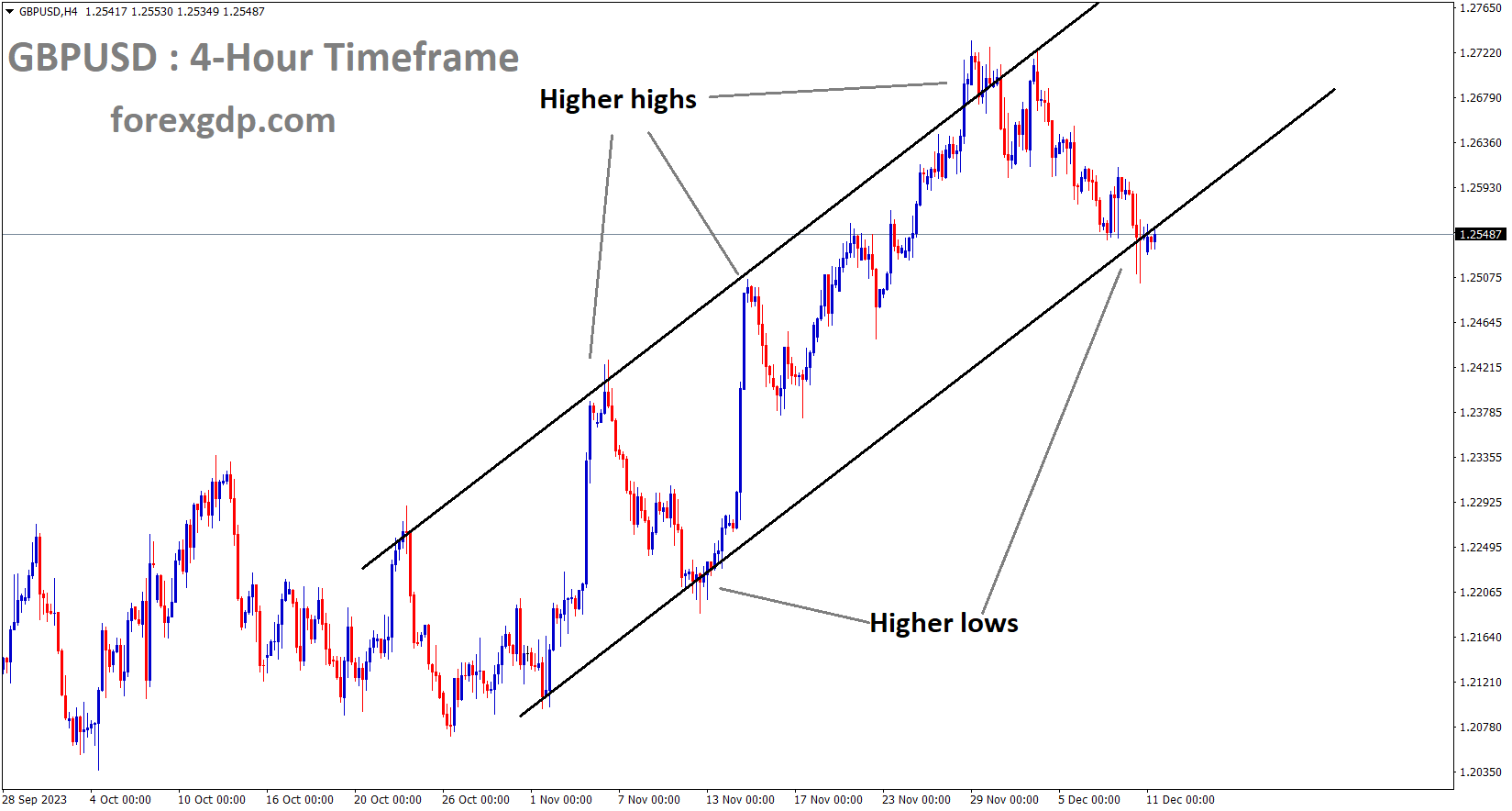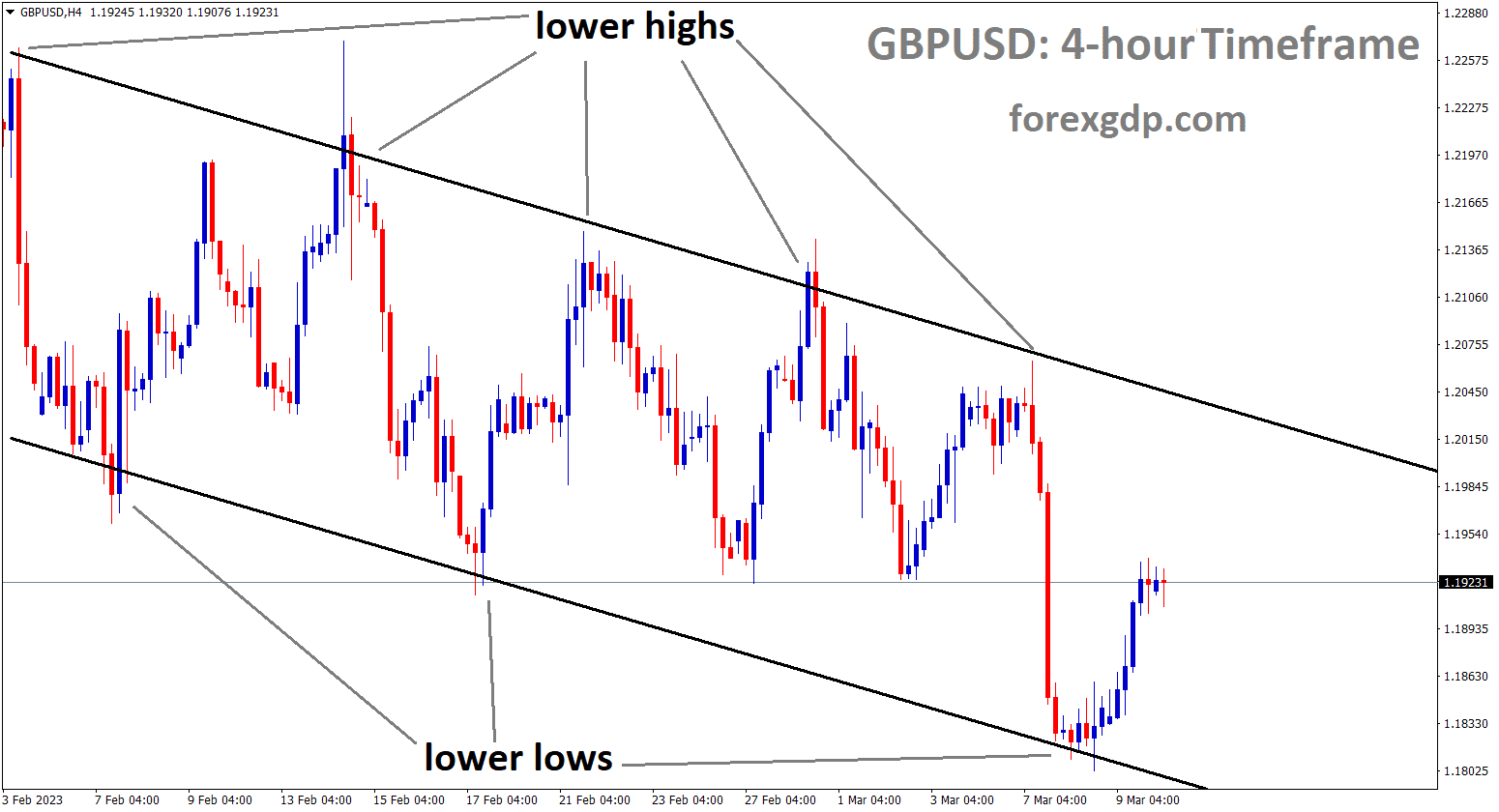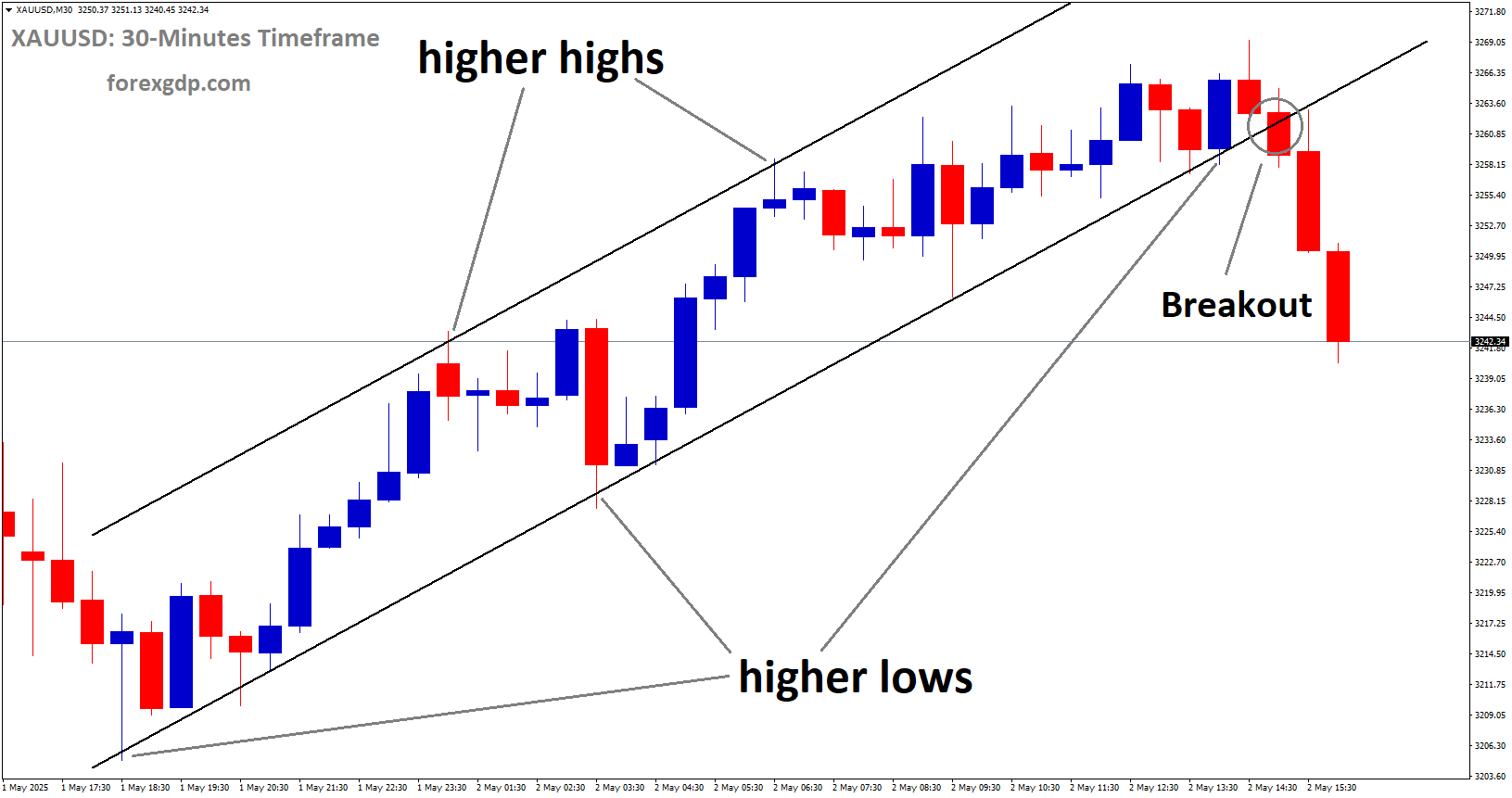GOLD Analysis:
XAUUSD is moving in a ascending channel and the market has reached the higher low area of the channel
Gold prices saw a decline following the release of robust US Non-Farm Payrolls data last Friday. With the Federal Reserve meeting scheduled for this week, gold prices have undergone a correction and moved lower, following their extended rally from the previous Monday.
The price of gold underwent a significant reversal, dropping to a two-week low on Friday after reaching an all-time high the previous week. This decline followed the release of stronger-than-expected employment data from the United States. The highly-watched US jobs report indicated the resilience of the US labor market, prompting investors to scale back their expectations for a 25 basis points interest rate cut by the Federal Reserve (Fed) in March 2024. As a result, US Treasury bond yields and the US Dollar both rose, exerting downward pressure on the price of gold.
Furthermore, the relative stability in the equity markets contributed to the continued depreciation of gold for a second consecutive day on Monday. However, concerns about a potential global economic downturn, particularly in China, as well as ongoing geopolitical risks, provided some support to the precious metal and prevented more substantial losses. Traders also appeared cautious in making bold moves ahead of key data releases and central bank events scheduled for this week.

On Tuesday, the focus will be on US consumer inflation figures, followed by the outcome of the critical two-day FOMC meeting on Wednesday. The “dot plot” from the Fed, which offers insights into interest rate projections for the coming year, will be closely monitored and could impact the non-yielding gold price. Additionally, the Swiss National Bank, the Bank of England, and the European Central Bank (ECB) are set to announce policy updates on Thursday. Subsequently, attention will shift to the release of flash PMI data from the Eurozone, the UK, and the US, providing further insights into the global economy’s health and influencing the precious metal.
Following the release of upbeat US jobs data, the benchmark 10-year US Treasury yield rebounded from a three-month low and bolstered the US Dollar, putting pressure on the price of gold on Friday. The US NFP report revealed the addition of 199,000 new jobs in November, surpassing estimates of 180,000 and exceeding the previous month’s 150,000 rise. Despite an increase in the Labor Force Participation Rate, the US Bureau of Labor Statistics (BLS) reported a decline in the Unemployment Rate from 3.9% in October to 3.7%, indicating underlying strength in the labor market. This led traders to speculate that the Federal Reserve might not implement an interest rate cut until May 2024.
Additionally, on Friday, Iran-backed militias in Iraq and Syria targeted US troops with rockets and drones multiple times due to US support for Israel amid the conflict in Gaza. An attack on the US embassy in Baghdad added to concerns of an expanding Middle East conflict. As traders await this week’s US consumer inflation figures and the Fed’s interest rate projections for the next year, they remain cautious about taking aggressive directional positions. The week ahead is marked by monetary policy meetings at the Swiss National Bank, the Bank of England, and the European Central Bank, all scheduled for Thursday.
SILVER Analysis:
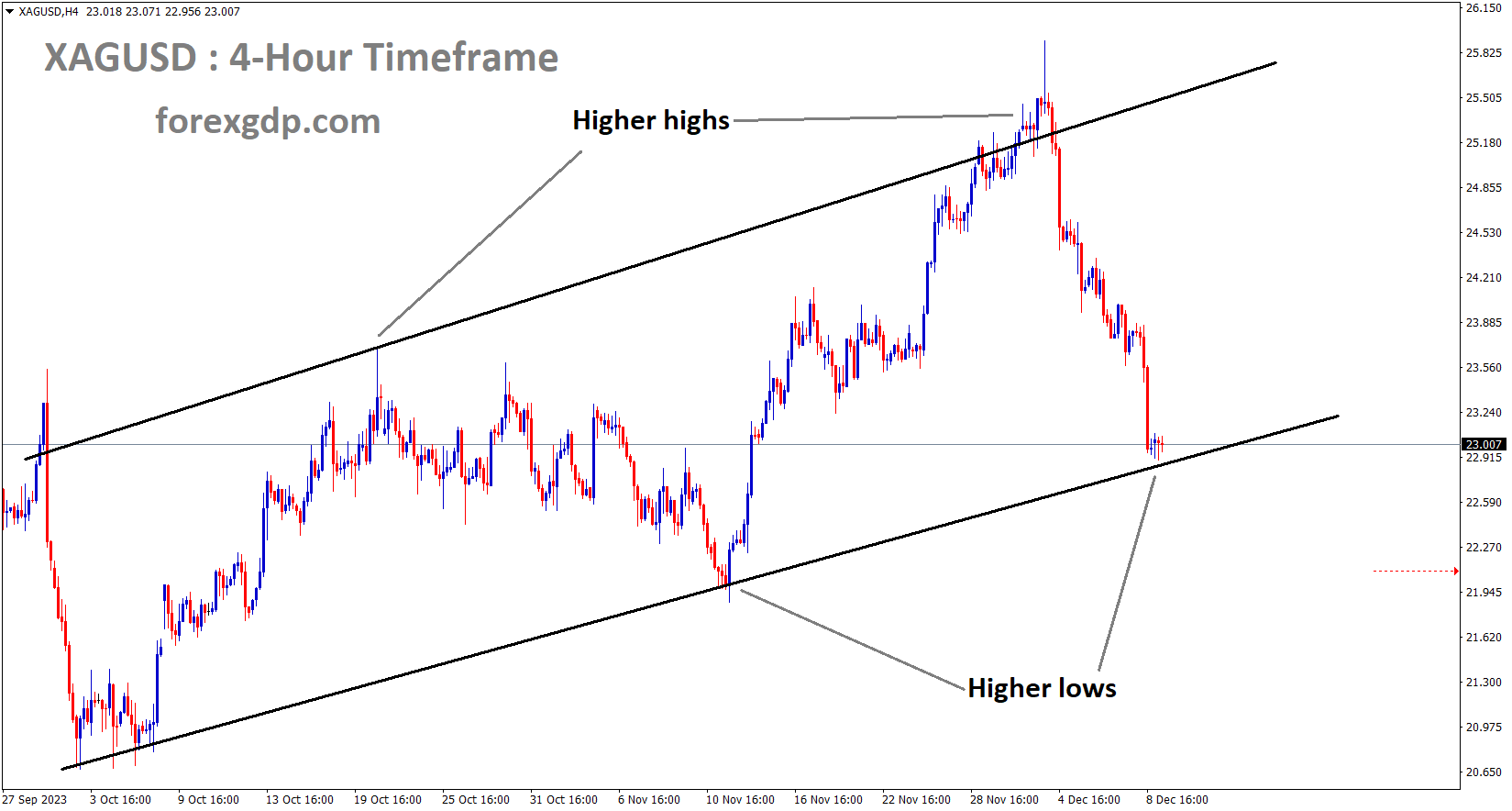
XAGUSD is moving in a ascending channel and the market has reached the higher low area of the channel
The US Non-Farm Payroll data exceeded expectations, reporting 199,000 jobs added compared to the anticipated 180,000, which strengthened the USD against other currencies. Analysts largely anticipate that this week’s FED meeting will likely result in the decision to maintain current interest rates. Additionally, the unemployment rate decreased from 3.9% to 3.7%.
The U.S. Bureau of Labor Statistics released its report today, indicating that the United States added 199,000 jobs in November. This resulted in a slight drop in the unemployment rate to 3.7 percent. While the employment growth is below the average monthly increase of 240,000 jobs over the past year, it aligns with recent trends in job growth. This report presents a mixed picture for the Federal Reserve as they approach their upcoming meeting.
The rise in hourly earnings and the decrease in unemployment may pose challenges for the Central Bank. Job gains were observed in the healthcare and government sectors, while manufacturing saw an increase in employment due to workers returning from a strike. On the flip side, the retail trade sector experienced a decline in employment. Manufacturing employment increased by 28,000, which was slightly below expectations, primarily due to the return of automobile workers following the resolution of the UAW strike.

In November, average hourly earnings for all private nonfarm payroll employees rose by 12 cents, or 0.4 percent, reaching $34.10. Over the past year, average hourly earnings have seen a 4.0 percent increase. Private-sector production and nonsupervisory employees also witnessed a 0.4 percent rise in average hourly earnings to $29.30.
Lately, there have been some positive developments for the U.S. Federal Reserve, with the 10-year yield retreating to around 4 percent. Despite signs of an economic slowdown, concerns persist regarding the labor market and the service sector. This has led to an increase in market expectations for rate cuts. While the data released slightly outperforms estimates, it may not fundamentally alter the landscape. The positive results across the three major indicators in report will undoubtedly give the Fed reason to contemplate their next steps, especially considering that average earnings could sustain demand in the future.
As the dust settles from jobs report and ahead of the FOMC Meeting, it will be intriguing to monitor the trajectory of rate cut expectations. The looming question is whether Fed Chair Powell will need to tailor his messaging at the upcoming meeting based on market expectations.
USDCHF Analysis:
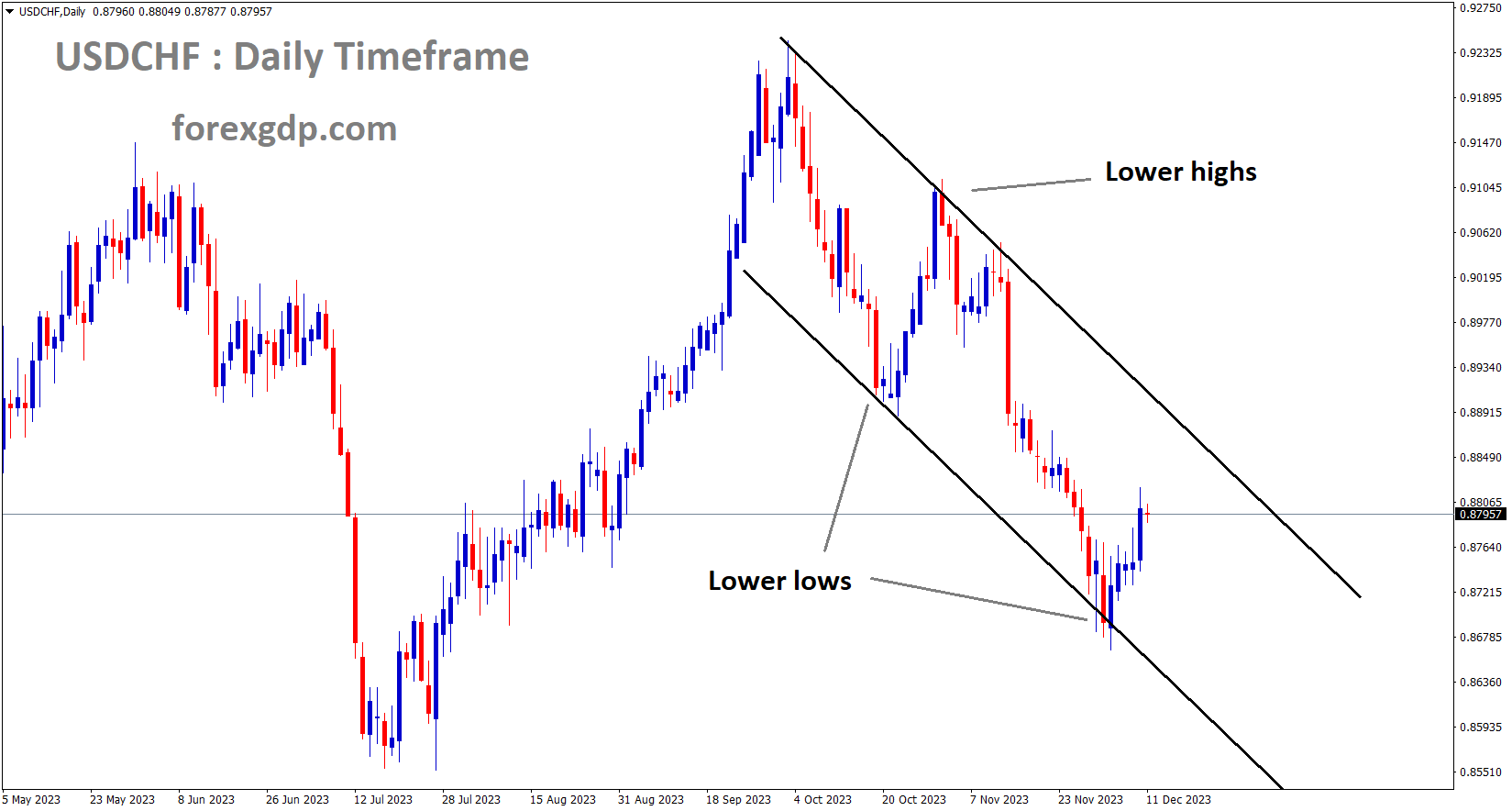
USDCHF is moving in descending channel and the market has rebounded from the lower low area of channel
The Swiss Franc has experienced a decline in trading value against major currencies such as the USD, GBP, and Euro due to the upcoming meetings of the Federal Reserve, Bank of England, European Central Bank (ECB), and Swiss National Bank scheduled for this week.
The Swiss Franc experienced a decline against the US Dollar on Friday following the release of the US Nonfarm Payrolls report, which revealed a higher-than-expected number of job creations in November, indicating a robust labor market. According to the report from the US Bureau of Labor Statistics, 199,000 new positions were added, surpassing economists’ expectations of 180,000.

Additionally, the report indicated that the US Unemployment Rate dropped to 3.7% in November, down from 3.9% in October, contrary to expectations of no change. Average Hourly Earnings also exceeded expectations at 0.4%, surpassing the anticipated 0.3%, suggesting the possibility of building wage inflation pressures. Furthermore, Hours Worked increased, indicating the filling of more full-time positions.
The higher wage data and stronger overall employment metrics suggest that the US economy is in better health than previously believed and that there may be emerging inflationary pressures. This data could lead the Federal Reserve to consider maintaining higher interest rates for a more extended period and reconsidering the possibility of interest rate cuts. Higher and more prolonged interest rates are likely to attract capital inflows, benefiting the US Dollar.
EURUSD Analysis:
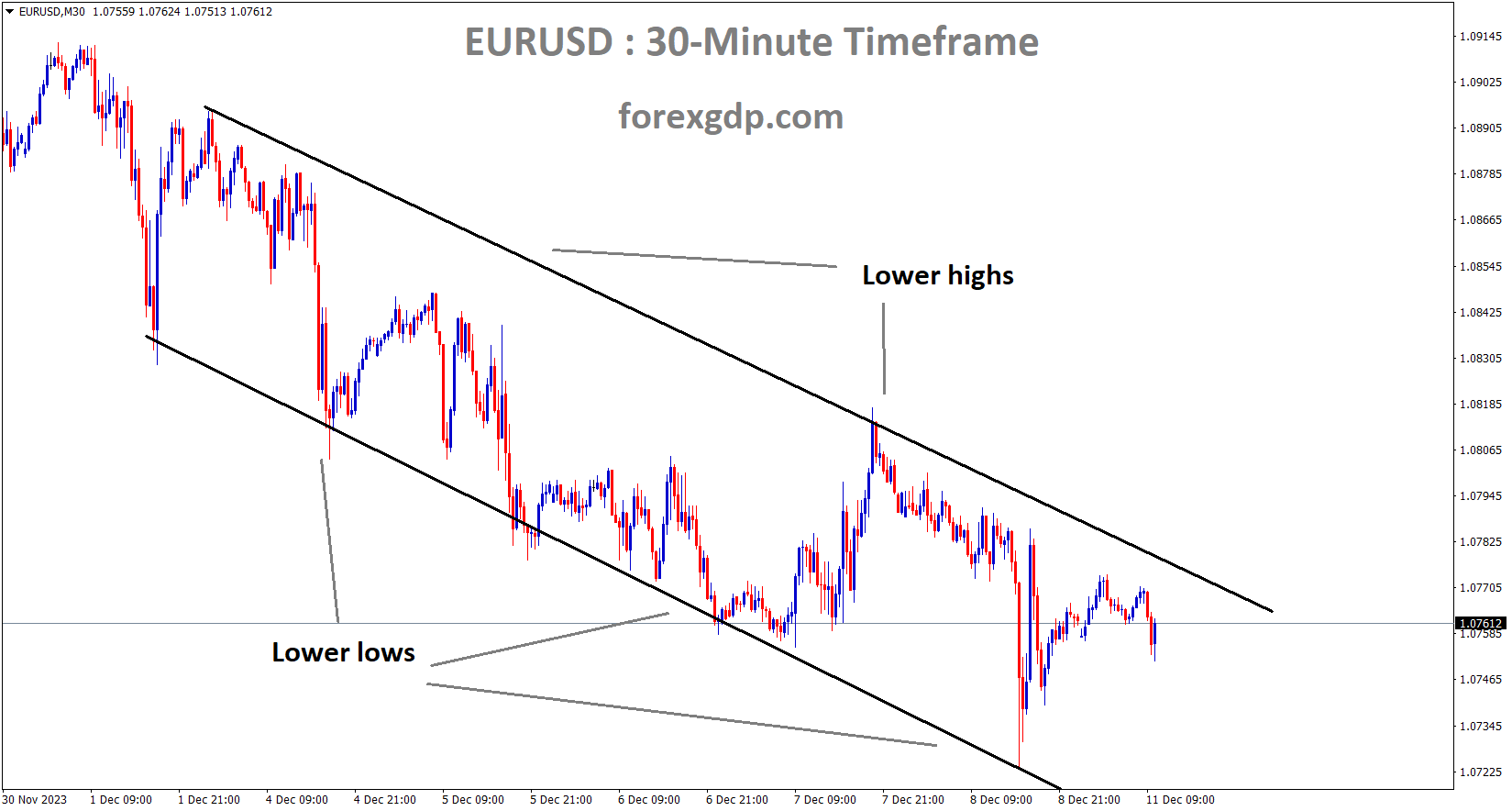
EURUSD is moving in descending channel and the market has reached the lower high area of channel
The upcoming ECB monetary policy decision, set for this week, is widely anticipated to result in the maintenance of interest rates, primarily due to the recent release of Euro area Q3 GDP figures. Last week, these figures indicated stagnation, with a reported value of -0.10%. This data has led analysts to predict that the ECB will opt to keep interest rates unchanged for the upcoming week.
The Euro encountered challenges in the previous week due to a downward revision of the Euro Area Q3 GDP figure. This revision affirmed the economic stagnation within the Euro Area and has cast a pessimistic shadow over the upcoming ECB meeting .

During the past week, Euro pairs were largely influenced by external factors and the revised GDP data. This ECB meeting, along with the release of updated economic forecasts, is anticipated to be of great significance for the Euro Area.
EURCHF Analysis:
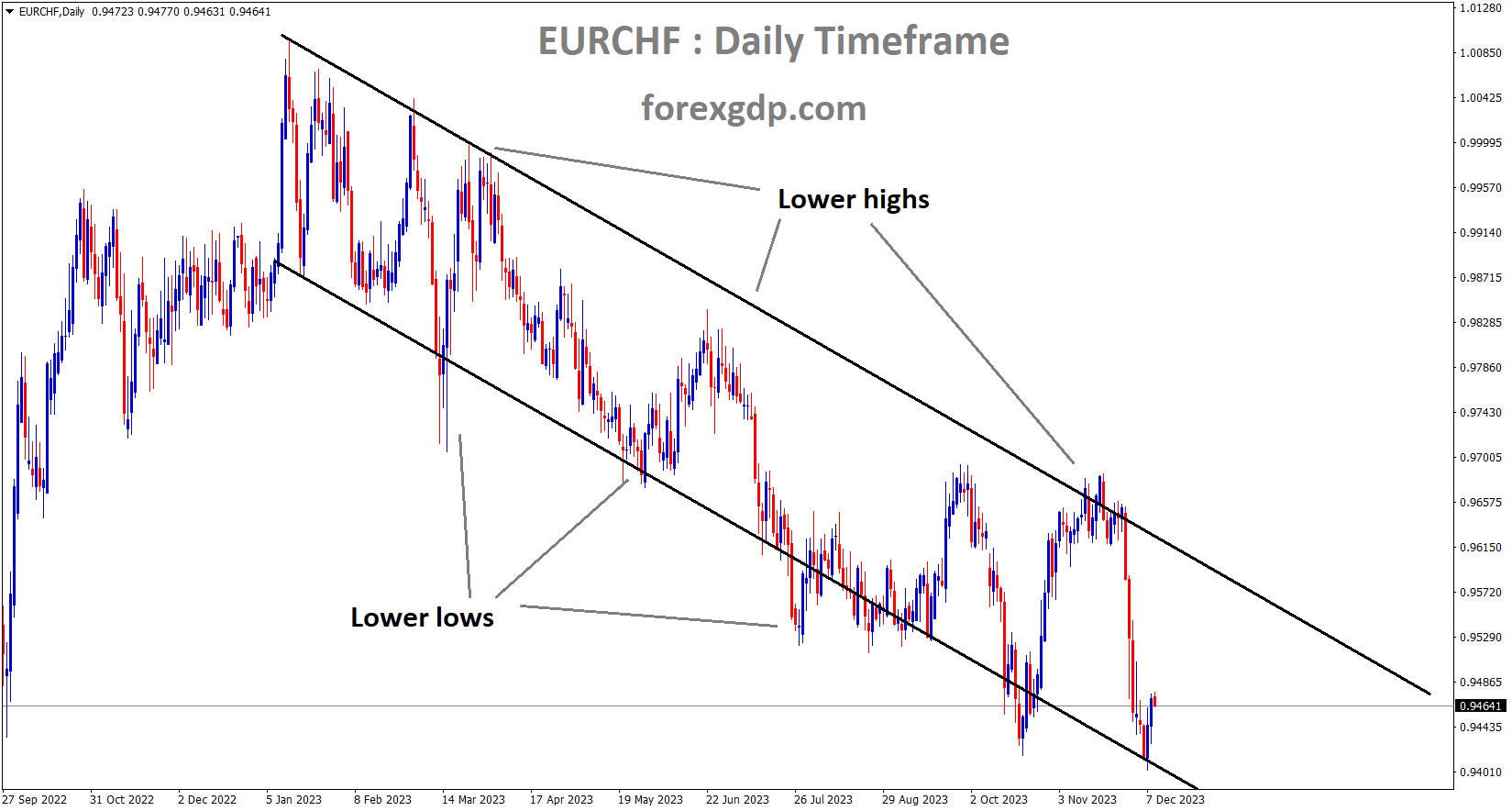
EURCHF is moving in descending channel and the market has rebounded from the lower low area of channel
It is widely expected that the ECB will maintain its current interest rates. As a result, the key focus of the meeting will be on the newly updated economic forecasts and the statements made by the ECB officials. Market sentiment continues to reflect an anticipation of a 125 basis points easing by the ECB in 2024. Consequently, there will be a keen interest in comparing these market expectations with the Central Bank’s projections. A notable discrepancy between the ECB’s outlook and market predictions could potentially bolster the Euro’s strength.
However, the Euro’s response will also hinge on how the financial markets interpret the ECB’s forecasts, as we have witnessed instances where market participants have diverged from the Central Bank’s stance.
GBPUSD Analysis:
GBPUSD is moving in a ascending channel and the market has reached the higher low area of the channel
This week, the Bank of England is set to announce its interest rate decision, and it coincides with a cooling of UK CPI data to 4.6% in October. Additionally, employment data is on the agenda for this week. It is widely anticipated that the Bank of England will likely maintain the current interest rates, but any future rate hikes will depend on data and could be considered in upcoming meetings.
The US Nonfarm Payrolls outperformed market expectations, with 199,000 new jobs added to the US economy in November, surpassing the previous month’s figure of 150,000 payroll additions. Additionally, the Unemployment Rate decreased from 3.9% to 3.7%, while Average hourly earnings remained steady at 4.0% year-on-year. Looking ahead, traders are eagerly anticipating key events from the upcoming FOMC and BoE meetings this week, which have the potential to inject volatility into the market. Bank of England Governor Andrew Bailey had previously emphasized that it was premature to consider rate cuts, despite a decline in the Consumer Price Index from 6.7% in September to 4.6% in October. As a result, it is widely expected that the BoE will maintain borrowing costs at a 15-year high during its December meeting on Thursday.

Notably, Federal Reserve Chair Jerome Powell had recently stated that it would be too early to confidently conclude that the Fed had adopted a sufficiently restrictive stance to control inflation. Powell emphasized the Fed’s readiness to tighten policy further if necessary. However, the upbeat US Nonfarm Payrolls report has led some investors to speculate that the Fed might postpone rate cuts in 2024. Market participants will also keep a close watch on UK employment data, including Employment Change, Claimant Count Change, and ILO Unemployment Rate, scheduled for release on Tuesday. Furthermore, the US Consumer Price Index (CPI) data will be published later that day, adding to market interest. Ultimately, attention will turn to the US FOMC meeting on Wednesday and the Bank of England policy meeting on Thursday, where pivotal decisions and statements are expected to shape market dynamics.
GBPJPY Analysis:
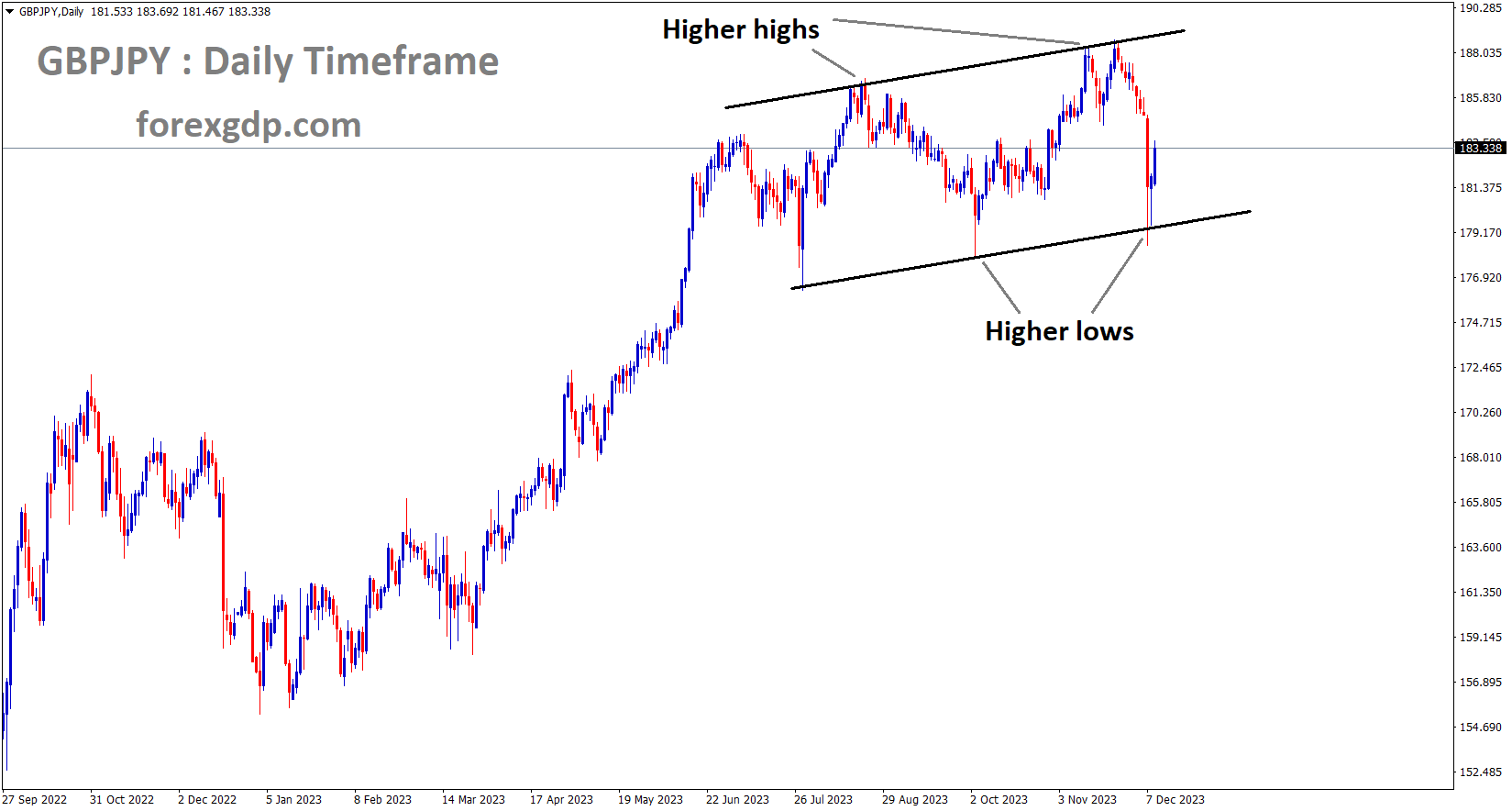
GBPJPY is moving in a ascending channel and the market has rebounded from the the higher low area of the channel
The Bank of Japan Governor has suggested that a policy shift may be on the horizon if wage increases align with inflation trends in the market. Last week, the Q3 GDP figures were considerably lower than initial expectations, adding pressure on the Bank of Japan to reconsider its loose monetary policy measures.
The Japanese Yen experienced a turbulent end to the previous week and Japan’s GDP fell significantly short of expectations, with the quarter on quarter figure slipping into negative territory, raising concerns about a potential recession in the near future. These economic conditions may prompt the Bank of Japan to exercise caution in tightening its monetary policy, despite the presence of high inflation levels. Although there have been hints from BoJ Governor Ueda regarding a possible policy shift, I do not anticipate any major moves during the December meeting, as they are likely to take a gradual approach.

The Japanese central bank’s decisions will heavily rely on economic data, particularly with regard to inflation and labor statistics, as robust additional evidence will be necessary to persuade the BoJ to alter its current stance. Money markets are currently pricing in an interest rate hike around September or October 2024, aligning with my expectation of no significant changes in the immediate future.
CADCHF Analysis:
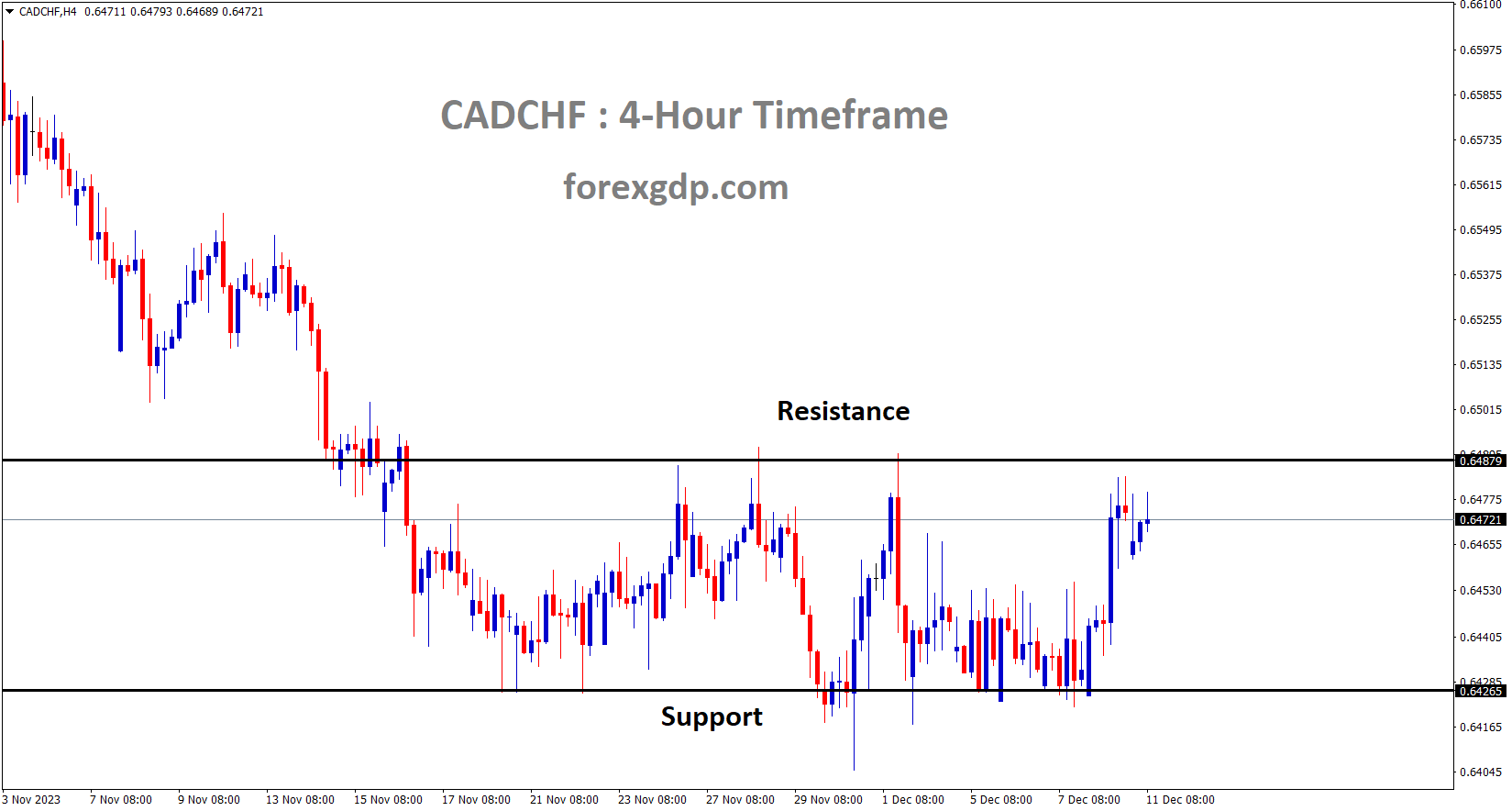
CADCHF is moving in a box pattern and the market has reached the Resistance area of the pattern
The Canadian Dollar gained strength in response to the release of higher-than-expected US Non-Farm Payroll data last Friday. Meanwhile, oil prices remained stable, and the Bank of Canada’s Governor is set to deliver a speech this coming Friday.
The Canadian Dollar made modest gains in the foreign exchange market on Friday, recovering from recent declines. However, the gains were marginal, and the charts still exhibit volatility as investors adjust their positions and expectations following the surprisingly positive US Nonfarm Payrolls report for November. The CAD ended Friday with a slight increase of one-tenth of a percent against the US Dollar. Its strongest performance was against the New Zealand Dollar, where it rose by approximately seven-tenths of a percent on the last trading day of the week.
On the economic data front, Bank of Canada Governor Tiff Macklem is scheduled to speak at the Canadian Club of Toronto. During this event, Governor Macklem is expected to address audience questions. In the broader FX market, the Canadian Dollar showed strength on Friday, gaining ground against all other major currencies, with the US Dollar coming in a close second. The US Dollar initially advanced ahead of Friday’s US Nonfarm Payrolls report but retraced its steps after the release. The NFP report for November exceeded expectations, with nearly 200,000 new jobs added, well above the forecasted 180,000 and a significant improvement from October’s 150,000 figure. Despite the shift in risk sentiment following the positive NFP report, investors remain cautious and will closely monitor recent data as they look ahead to 2024, paying particular attention to potential revisions. Notably, in the last twelve consecutive NFP releases, all but four were later revised downward, with only two being revised upward. The most recent two releases have not yet undergone revisions.

Additionally, the University of Michigan’s Consumer Sentiment Index significantly exceeded expectations, registering at 69.4, well above the forecasted 62.0 and extending its lead over November’s reading of 61.3. In the upcoming week, investors will keep a close eye on US Consumer Price Index inflation figures and the Federal Reserve’s final Interest Rate Decision. Markets will be eager to see any updates to the Fed’s ‘dot plot,’ which outlines interest rate projections. Crude Oil experienced a moderate rebound after a week of declines. West Texas Intermediate Crude Oil climbed to $71.50 per barrel on Friday, recovering from a nearly 8% drop from Monday’s opening price, which had fallen to $69.01 per barrel on Thursday. This rebound in Crude Oil prices, even if slight, is welcome news for the Canadian Dollar, which remains down by eight-tenths of a percent against the US Dollar since the start of the week.
AUDUSD Analysis:
AUDUSD is moving in a ascending channel and the market has fallen from the the higher high area of the channel
China’s economy has entered a deflationary phase following the release of negative Consumer Price Index and Producer Price Index (PPI) data. Tomorrow, RBA Governor Michelle Bullock is slated to deliver a speech.
The statement from China’s Communist Party Politburo outlines the monetary policy for 2024, which is set to remain accommodating given the current economic conditions. The economy has been following a relatively weaker trajectory thus far. To stimulate growth in the business and real estate sectors, we are implementing additional supportive measures within our monetary policy framework. The Australian Dollar continued to decline for the second consecutive session on Monday. The strength of the United States’ employment figures on Friday bolstered the US Dollar, putting downward pressure on the AUDUSD pair. Additionally, concerns about deflation in China, along with a Consumer Price Index and Producer Price Index (PPI) that fell short of expectations, led to a selling spree of the Australian Dollar. On Friday, the US Bureau of Labor Statistics released data showing that November’s US Nonfarm Payrolls exceeded market forecasts. Simultaneously, the Unemployment Rate declined during the same period. Consequently, US Treasury yields experienced an upward surge, supporting the strengthening of the USD. The robust employment data sparked discussions and speculations about the future path of the US Federal Reserve’s (Fed) monetary policy and how long the central bank intends to maintain rates at restrictive levels. The focus will be on the US Consumer Price Index (CPI) on Tuesday and the Fed Interest Rate Decision on Wednesday.

Michele Bullock, the Governor of the Reserve Bank of Australia , is scheduled to deliver a speech on Tuesday. The RBA opted to keep the cash rate at 4.35% during its December meeting. While the RBA maintains a tightening bias, recent economic indicators suggest that there may not be further rate hikes in the near future.Last week, Australia’s Trade Balance data was released, showing a surplus of 7,129M, slightly lower than the expected 7,500M in October. In China, the Consumer Price Index experienced a year-on-year decline of 0.5% in November, compared to a 0.2% decrease in October. On a monthly basis, Chinese inflation dropped by 0.5%, surpassing the 0.1% decline observed in October. China’s Producer Price Index recorded a 3.0% year-on-year drop in November, reflecting a more significant decline than the 2.6% decrease reported in October.In the United States, the Nonfarm Payrolls for November increased by 199,000, exceeding the previous month’s rise of 150,000 and the market expectation of 180,000. US Average Hourly Earnings Year-on-Year remained steady at 4.0%, aligning with market projections for November. Meanwhile, the Unemployment Rate dropped to 3.7% from the previous 3.9%. The preliminary Michigan Consumer Sentiment Index for December reached 69.4, a notable increase from the previous reading of 61.3.
The Politburo of China’s Communist Party issued a statement following its meeting on Friday. It was announced that in 2024, proactive fiscal policies will be maintained and made more forceful and efficient. Additionally, prudent monetary policies will be upheld, with a focus on flexibility and precision. The government intends to strengthen counter cyclical and cross-cyclical macroeconomic policies while enhancing the resilience and security of industrial supply chains. Furthermore, efforts will be made to boost domestic demand, deepen reforms in key areas, and expand levels of openness. The stability of foreign trade and capital will be ensured, and measures will continue to be implemented to prevent and mitigate risks in critical areas. The government aims to enhance the consistency of macroeconomic policies and will persist in deepening anti-corruption initiatives. Addressing more prominent issues related to industrial, systemic, and regional corruption is also on the agenda. It is noted that the current economic recovery in the country remains in a critical stage.
NZDUSD Analysis:
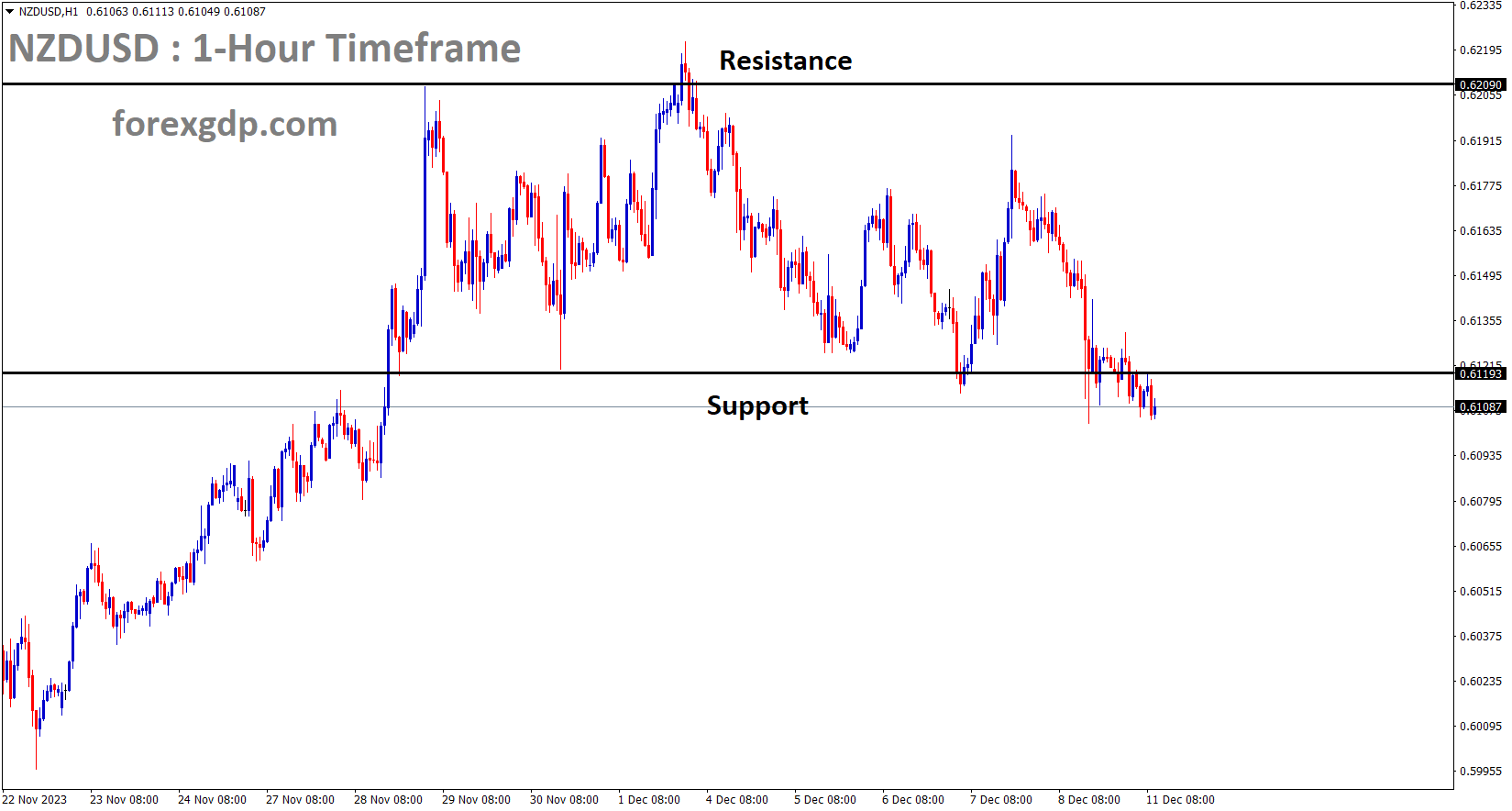
NZDUSD is moving in a box pattern and the market has reached the support area of the pattern
The New Zealand Dollar saw a decrease in value against the US Dollar following the release of robust domestic data from the United States last Friday. This week, New Zealand is set to unveil its Q3 GDP data, with expectations for a reading of 0.20%, down from the previous figure of 0.90%.
The US Department of Labor recently released its November Nonfarm Payrolls report, painting a more optimistic picture of the labor market than previously indicated earlier in the week. The report revealed the addition of 199,000 jobs to the economy, surpassing both October’s figure of 150,000 and the market forecast of 180,000. Consequently, the unemployment rate declined from 3.9% to 3.7%, and Average hourly earnings remained at 4% over the past 12 months, suggesting that concerns of a wage-price spiral are unwarranted. In response to this data release, the NZDUSD exhibited significant volatility, experiencing a wide range of fluctuations and ultimately declining to its lowest point.

Additionally, the University of Michigan conducted its latest consumer survey, which indicated that American households are more optimistic about the economic outlook. The Consumer Sentiment Index increased to 69.0, marking its highest level since August. Furthermore, inflation expectations were revised downward. The US Dollar Index, which measures the performance of the US dollar against six major currencies, rose by 0.30%, reaching 104.01. This upward movement was supported by a rise in US yields, with the US 10-year bond yield increasing by 8 basis points and poised to conclude the week at 4.236%.
Meanwhile, in New Zealand, the upcoming economic calendar will feature the Current Account and Gross Domestic Product figures for the third quarter. Projections suggest a growth rate of 0.2%, which is lower than the previous quarter’s expansion of 0.9%. In the United States, traders are gearing up for the following week’s release of the US inflation report and the Federal Open Market Committee meeting, which are expected to be significant market events.
Don’t trade all the time, trade forex only at the confirmed trade setups.
Get more confirmed trade setups here: forexgdp.com/buy/

